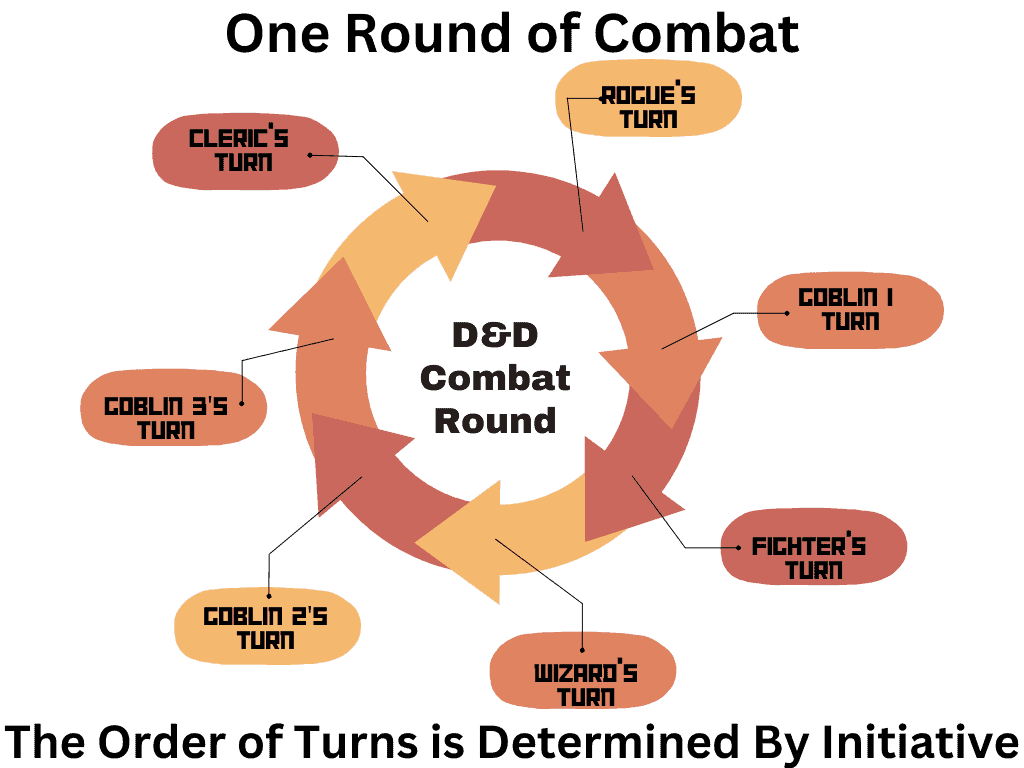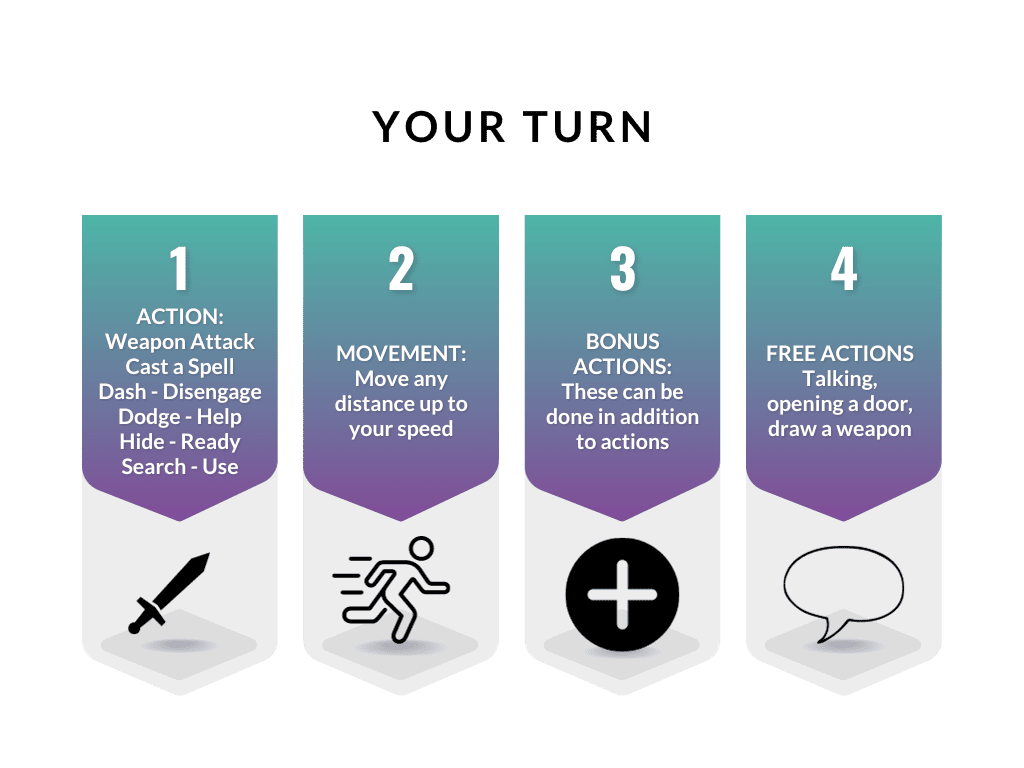When we talk about Combat in D&D, we’re trying to figure out a fair way to determine who wins in a fight. The first step is to figure out the rules, and then we can play it out to see what happens.
Here are the official steps to combat:
Combat Step by Step
- Determine Surprise. The GM determines whether anyone involved in the combat encounter is surprised.
- Establish Positions: The GM decides where all the characters and monsters are located. Given the adventurers’ marching order or their stated positions in the room or other location, the GM figures out where the adversaries are, how far away, and in what direction.
- Roll Initiative: Everyone involved in the combat encounter rolls initiative, determining the order of combatants’ turns.
- Take Turns. Each participant in the battle takes a turn in initiative order.
- Begin the Next Round. When everyone involved in the combat has had a turn, the round ends. Repeat step 4 until the fighting stops.
- 5th Edition SRD
Surprise is simply figuring out if each group knows the others are there. Meaning did you walk into a spot where some goblins were hiding? Did you see them?
Positions are basically where everyone is standing.
Initiative is figuring out who was quickest to act.
Turns are the order each player and monster acts. You take actions on your turn in combat.
If you think about a game like Chess, you can’t just move whenever you want. You have to take turns and follow the rules of how the pieces move.
In D&D Combat is done in Rounds. A round is a short chunk of time (roughly 6 seconds) in which everyone that can act, gets to choose what they want to do on their turn.
Just like Chess, you take turns. You figure out what order the turns go in by something called Initiative.
So just think of it like this: Each round of combat, everyone get’s a turn. You take actions on your turn.
Here is what a round of combat looks like as a graphic:

So in this example, a Fighter, a Rogue, a Wizard and a Cleric are fighting 3 Goblins. They all roll dice to determine their Initiative, and add any bonuses they might have.
The highest initiative goes first, followed by the second highest, and so on. If there are any tie scores, the DM can rule on a tie breaker.
In the above example, let’s say the initiative rolls went like this:
Rogue – 18
Goblin 1 – 16
Fighter – 15
Wizard – 13
Goblin 2 – 11
Goblin 3 – 10
Cleric – 7
The Rogue was highest and goes first. Followed by Goblin 1, the Fighter and so on around the wheel. Once the last player or monster takes it’s turn, the round is over. You move on to the next Round, and go in the same order. No initiative rolls each round.
So now we know when everyone get’s a turn. What can you do on your turn?
Your Turn in Combat
On your turn, you can move a distance up to your speed and take one action.
Your turn is made up of the following four categories: Actions, Movement, Bonus Actions and Free Actions (also known as interacting with objects)

Actions in Combat: We discuss all of the Actions in Combat in depth, but let’s do a summary here:
- Attack: The most common action to take in combat, whether you are swinging a sword, firing an arrow from a bow, or brawling with your fists.
- Cast a Spell: Spellcasters such as wizards and clerics, as well as many monsters, have access to spells and can use them to great effect in combat.
- Dash: When you take the Dash action, you gain extra movement for the current turn.
- Disengage: If you take the Disengage action, your movement doesn’t provoke opportunity attacks for the rest of the turn.
- Dodge: The Dodge action gives you a bonus to your AC, making you harder to hit.
- Help: The Help action gives an ally advantage on an attack roll, ability check, or saving throw.
- Hide: The Hide action lets you try to conceal yourself from enemies.
- Ready: The Ready action lets you take a specific action later, when a certain trigger occurs.
- Search: The Search action lets you look for something specific.
- Use an Object: The Use an Object action lets you interact with an object or feature of the environment.
- Grapple: When you want to grab a creature or wrestle with it, you can use the Attack action to make a special melee attack, a grapple.
- Shove: Using the Attack action, you can make a special melee attack to shove a creature, either to knock it prone or push it away from you.
- Improvised Action: Anything outside the options listed here. Example “I would like to shoot the rope holding the chandelier above that monsters head so it falls on him”
Movement: If you look at your character sheet, you should see a “Movement Speed” or “Speed” section. This is the distance you can move on your turn, typically in feet.
If your speed is 30 feet, you can move any distance up to that 30 feet. You can also break it up however you would like to. For example move 10 feet, cast a spell, then move 15 more feet, open a door, then move your final 5 feet.
You can also choose to move less than the maximum or not move at all.
If you have more than one speed type, say flying and walking, you can switch between them. Subtract from each as you move, they do not add together.
If you are in Difficult Terrain, your movement speed is doubled.
If you are Prone (i.e. on the ground), it costs half your speed to get back up. You can fall to the ground for no movement cost, and crawling is double movement cost.
Bonus Actions: Certain class features, spells and other abilities let you take an additional action on your turn called a Bonus Action.
For example the spell Misty Step has a casting time of 1 bonus action.
You can take only one bonus action on your turn, so you must choose which bonus action to use when you have more than one available.
Free Actions: This includes things that are considered fluid enough to do alongside other things. For example you could yell to your party “Watch out, they’re immune to fire damage!”
You can also take actions considered quick enough to not warrant a full action. For example opening a door or unsheathing your sword.
Drinking a potion on the other hand, is something that would consume your full action.
Reactions: A reaction is a response to a trigger. This can happen on your turn or on someone else’s.
The common example is an Opportunity Attack, which happens when an enemy tries to leave your reach. So if the goblin you were fighting decides to run away, if you have a reaction, you can try to hit it as it tries to leave.
You only get one reaction per turn.
Making an Attack
Cover
A target has half cover if an obstacle blocks at least half of its body. The obstacle might be a low wall, a large piece of furniture, a narrow tree trunk, or a creature, whether that creature is an enemy or a friend.
A target with three-quarters cover has a +5 bonus to AC and Dexterity saving throws. A target has three-quarters cover if about three-quarters of it is covered by an obstacle. The obstacle might be a portcullis, an arrow slit, or a thick tree trunk.
A target with total cover can’t be targeted directly by an attack or a spell, although some spells can reach such a target by including it in an area of effect. A target has total cover if it is completely concealed by an obstacle.
We have a full guide on Cover that deals with this topic in depth.
Damage and Healing
This section deals with the following topics:
Hit Points:
Damage Rolls and Critical Hits
Resistances and Vulnerabilities
Healing
Mounted Combat
We have a full guide on Mounted Combat that covers everything including types of mounts and costs. Including fun exotic mounts like Elephants or a Gryphon.
Underwater Combat
We also have a full guide on going under water in D&D that includes combat and the rules around it.
Rich is an avid D&D player and DM. He has been playing since the Advanced Dungeons & Dragons 1st and 2nd editions. He has run campaigns of various editions with family and friends for over 20 years. Playing DnD 5th Edition in person at local game stores and online with VTT’s over the past 10 years has provided a consistent connection to how the game has grown. He strongly believes in understanding the source material, but catering the games to your individual players. Feel free to ask anything in the comments or drop him an email: [email protected].
